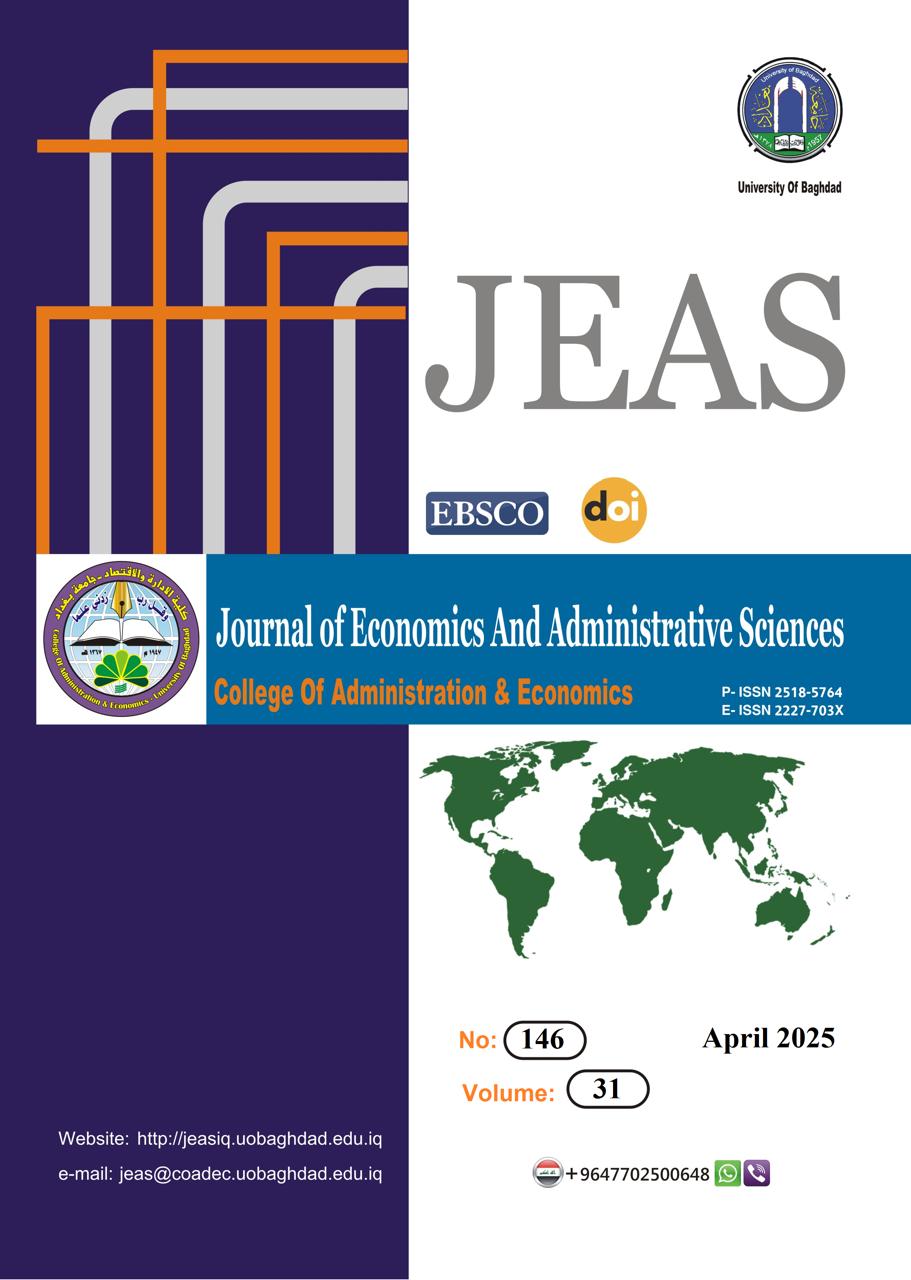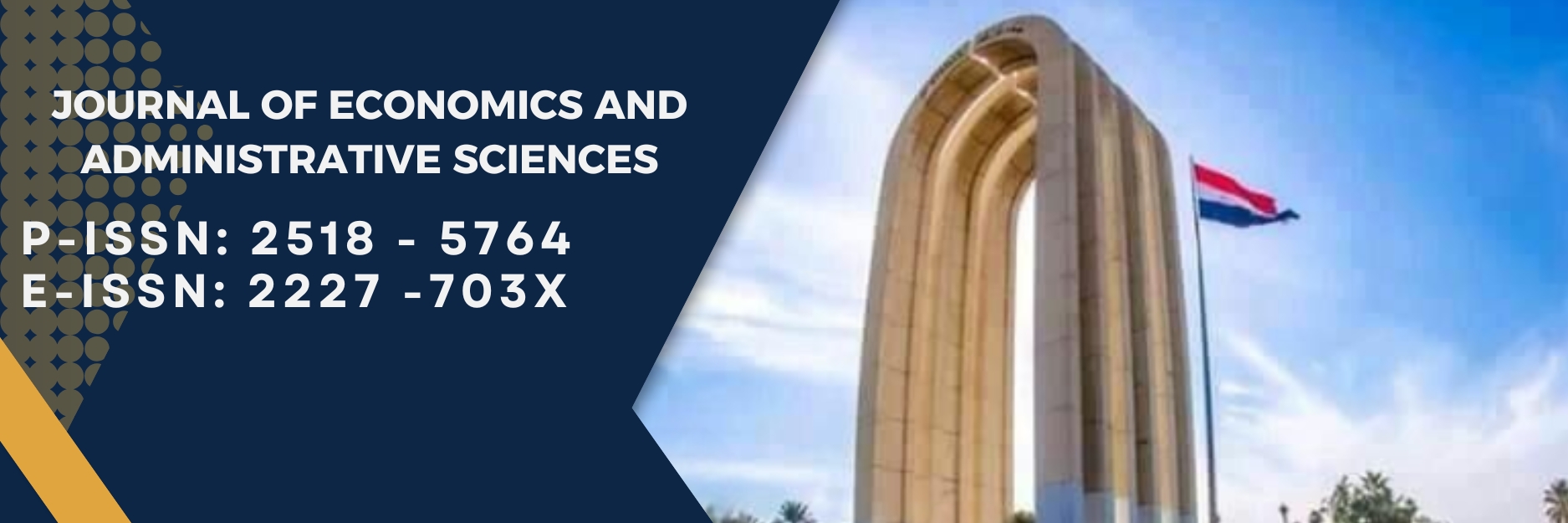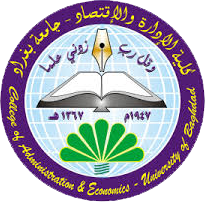Forecasting of the Dollar Exchange rate Using Exogenous Variables with the (IV4) Method and Some Kernel Functions
DOI:
https://doi.org/10.33095/ze0mh980Keywords:
Hybrid Forecasting Model, MISO ARX Model, GARCH-X Model, Model Order Determination, QMLE, Dollar Exchange Rate PredictionAbstract
This paper proposes a hybrid approach to dollar exchange rate forecasting, wherein both types of forecasting models-linear and non-linear models-have been incorporated to improve the efficiency of predictions. The work essentially combined MISO ARX model with GARCH-X models within MISO ARX framework to enhance the data. These three estimation techniques, namely IV4, RELS-HF, and RELS-SE, could optimize the modeling performance of the MISO ARX model, whereas Quasi Maximum Likelihood Estimation (QMLE) was applied for GARCH-X models.
An evaluation metric such as the Mean Absolute Error (MAE) and Mean Absolute Percentage Error (MAPE) was used for the comparison between model performances. The findings show that RELS-SE method is superior to other estimation methods for MISO ARX models, and the results also suggest that the best forecasting accuracy was obtained for the MISO ARX (1,5,3,5,3) - GARCH (1,2)-X model. It has been effective in hybridizing the exchange rate changes model for cash volatility predictions as the hybrid model excellent catch in capturing volatility. This grows importance for a hybrid model in financial forecasting, especially in turbulent markets.
It is valuable for policy makers, financial analysts, and economic researchers. It suggests that hybrid time series models could be used to improve the accuracy of exchange rate forecasting. Future research should include investigation into the combination of machine learning techniques with hybrid econometric models to further enhance prediction improve performance.
Downloads
References
Ahmmed Mohammed, F. and Abbas Mousa, M (2019). Applying Hybrid time series models for modeling bivariate time series data with different distributions for forecasting unemployment rate in the USA. Journal of Mechanics of Continua and Mathematical Sciences, 14(5), 351–368. https://doi.org/10.26782/jmcms.2019.10.00026
Akaike, H. (1974). A New Look at the Statistical Model Identification. IEEE Transactions on Automatic Control, 19(6), 716–723. https://doi.org/10.1109/TAC.1974.1100705
Allah, A. S. H., & Shalaka, J. K. (2013). Damage Currency Swap the Resulting From Government Departments Dealing With Trade Bank of Iraq From. Journal of Economics and Administrative Sciences, 19(73), 526. https://doi.org/10.33095/jeas.v19i73.997
Burnham K.P. and Anderson D.R. (2004). Multimodel Inference : Understanding AIC and BIC in Model Selection. Sociological Methods & Research.
https://doi.org/10.1177/0049124104268644
Bollerslev, T. (1986). Generalized autoregressive conditional heteroskedasticity. Journal of econometrics, 31(3), 307-327.
Chen, T. (2018). Automatica On kernel design for regularized LTI system identification . Automatica, 90, 109–122. https://doi.org/10.1016/j.automatica.2017.12.039
Chen, T., & Ljung, L. (2013). Implementation of algorithms for tuning parameters in regularized least squares problems in system identification . Automatica, 49, 2213–2220. https://doi.org/10.1016/j.automatica.2013.03.030
Chen, T., Ljung, L., Andersen, M., Chiuso, A., Carli, F., & Pillonetto, G. (2012). Sparse multiple kernels for impulse response estimation with majorization minimization algorithms. Proceedings of the IEEE Conference on Decision and Control, 1500–1505. https://doi.org/10.1109/CDC.2012.6426801
Colin, K., Bako, L., Bombois, X. (2021). Data Informativity for the Closed-Loop Identification of MISO ARX Systems. IFAC PapersOnLine, 54(7), 779–784.
https://doi.org/10.1016/j.ifacol.2021.08.456
Dai, W., & Tsang, K. W. (2021). Hybrid resampling confidence intervals for change-point or stationary high-dimensional stochastic regression models. Statistica Sinica, 31, 2239–2255. https://doi.org/10.5705/ss.202020.0439
Fakhri, M. A., & Mohammed, F. A. (2016). Applying some hybrid models for modeling bivariate time series assuming different distributions for random error with a practical application. Journal of Economics and Administrative Sciences, 26(117), 442-479.
https://doi.org/10.33095/jeas.v26i117.1824
Francq, C., & Zakoian, J. (2007). Quasi-maximum likelihood estimation in GARCH processes when some coefficients are equal to zero. Science Direct, 117, 1265–1284.
https://doi.org/10.1016/j.spa.2007.01.001
Hamid, Z. H., & Mohammed, F. A. (2018). Comparison Between Ordinary Methods (LS,IV) and Robust Methods (2SWLS,LTS,RA) to estimate the Parameters of ARX(1,1,1) Model for Electric Loads. Journal of Economics and Administrative Sciences, 24(109), 496–514. https://doi.org/10.33095/jeas.v24i109.1563.
Han, H., & Kristensen, D. (2014). Asymptotic Theory for the QMLE in GARCH-X Models With Stationary and Nonstationary Covariates. Journal of Business and Economic Statistics, 32(3), 416–429. https://doi.org/10.1080/07350015.2014.897954
Hickey, E., Loomis, D. G., & Mohammadi, H. (2012). Forecasting hourly electricity prices using ARMAX-GARCH models: An application to MISO hubs. Energy Economics, 34(1), 307–315. https://doi.org/10.1016/j.eneco.2011.11.011
Hu, H.-Y. (2019). Evaluating Multi-Horizon Volatility-Forecasting Performances of GARCH-Type Models. Master ’ s Thesis Financial Economics Evaluating Multi-Horizon Volatility-Forecasting Performances of GARCH-Type Models, February.
Ismail, Z. K., & Mohammed, F. A. (2021). Predicting Social Security Fund compensation in Iraq using the ARMAX model. Journal of Economics and Administrative Sciences, 27(125), 493-508. https://doi.org/10.33095/jeas.v27i125.2089
Janczura, J., & Pu´c, A. (2023). ARX-GARCH Probabilistic Price Forecasts for Diversification of Trade in Electricity Markets — Variance Stabilizing Transformation Financial Risk-Minimizing Portfolio Allocation. Energies, 1–18. https://doi.org/10.3390/en16020807
Kazim, B. B., & Hassan, F. T. (2017). Forecasting the use of Generalized Autoregressive Conditional Heteroscedastic Models (GARCH) Seasonality with practical application. Journal of Economics and Administrative Sciences, 23(96), 341–362.
https://doi.org/10.33095/jeas.v23i96.373.
Ketz, P. (2022). Allowing for weak identification when testing GARCH-X type models. Economics -, 1–28. https://doi.org/https://doi.org/10.48550/arXiv.2210.11398
Lee, J. H. H. (1991). A Lagrange multiplier test for GARCH models. Economics Letters 37 (1991) 265-271, 37, 265–271.
Linton, O. B. (2010). ARCH models. In Macroeconometrics and Time Series Analysis: Vol. IV (Issue 313, pp. 2960–27). https://doi.org/10.1057/9780230280830_2
Liu, H., & Shi, J. (2013). Applying ARMA – GARCH approaches to forecasting short-term electricity prices. Energy Economics, 37, 152–166.
https://doi.org/10.1016/j.eneco.2013.02.006
Ljung, L. (1999). System Identification Theory for the User Second Edition. Prentice Hall Information and System Sciences Series Thomas Kailath, Editor Astrom . printed in the United States of America
Ljung, L. (2013). Some Classical and Some New Ideas for Identification. J Control Autom Electr Syst (2013) 24:3–10, 3–10. https://doi.org/10.1007/s40313-013-0004-7
Md Yeasin, K.N. Singh, A. L. and R. K. P. (2020). Modelling Volatility Influenced by Exogenous Factors using an Improved Garch-X Model. 74(3), 209–216.
Mohammed, F. A., & Tawfeeq, H. A. (2021). Using Kernel Methods To Estimate The Parameters Of (Multiple Input- Single Output) ARX MODEL. International Journal of Agricultural & Statistical Sciences, 2021, Vol 17, P1311, 17(Dc), 1311–1321.
Mohammed, F. A., & Yadkar, A. S. (2015). Using ARCH , GARCH Models in Prediction at Daily Closing Price For Iraqi Stock Exchange index. Kirkuk University Journal of Administrative and Economic Sciences, 2, 237–266. https://doi.org/10.32894/1913-005-002-010
Ngailo, E., Luvanda, E., & Massawe, E. S. (2014). Time Series Modelling with Application to Tanzania Inflation Data. Journal of Data Analysis and Information Processing, 2, 49–59. https://doi.org/http://dx.doi.org/10.4236/jdaip.2014.22007.
Parwati, L. S., Nugrahani, E. H., & Budiarti, R. (2023). Forecasting Stock Price Using Armax-Garchx Model During The Covid-19 Pandemic. Mathline : Jurnal Matematika Dan Pendidikan Matematika, 8(2), 489–502. https://doi.org/10.31943/mathline.v8i2.413
Rachad, S., Nsiri, B., & Bensassi, B. (2015). System Identification of Inventory System Using ARX and ARMAX Models. International Journal of Control and Automation, 8(12), 283–294. https://doi.org/10.14257/ijca.2015.8.12.26
Tangirala, A. K. (2015). Principles Of System Identification Theory and Practice.Taylor & Francis Group, LLC.
Wang, W., Van Gelder, P. M., Vrijling, J. K., & Ma, J. (2005). Testing and modelling autoregressive conditional heteroskedasticity of streamflow processes. Nonlinear processes in Geophysics, 12(1), 55-66.
Yusof, F., Kane, I. L., & Yusop, Z. (2013). Jurnal Teknologi Science and Engineering, Elektronische Ressource. Jurnal Teknologi, 63(2), 27–34.
https://jurnalteknologi.utm.my/index.php/jurnalteknologi/article/view/1908/1447
Zhang, Y. (2011). Unbiased identification of a class of multi-input single-output systems with correlated disturbances using bias compensation methods. Mathematical and Computer Modelling, 53(9–10), 1810–1819. https://doi.org/10.1016/j.mcm.2010.12.059
Zhu, Y. (2001). Multivariable System Identification For Process Control. In Elsevier Science & Technology Books (Issue October). Elsevier Science & Technology Books. https://doi.org/10.1016/b978-0-08-043985-3.x5000-5.
Published
Issue
Section
License
Copyright (c) 2025 Journal of Economics and Administrative Sciences

This work is licensed under a Creative Commons Attribution-NonCommercial-NoDerivatives 4.0 International License.
Articles submitted to the journal should not have been published before in their current or substantially similar form or be under consideration for publication with another journal. Please see JEAS originality guidelines for details. Use this in conjunction with the points below about references, before submission i.e. always attribute clearly using either indented text or quote marks as well as making use of the preferred Harvard style of formatting. Authors submitting articles for publication warrant that the work is not an infringement of any existing copyright and will indemnify the publisher against any breach of such warranty. For ease of dissemination and to ensure proper policing of use, papers and contributions become the legal copyright of the publisher unless otherwise agreed.
The editor may make use of Turtitin software for checking the originality of submissions received.


























